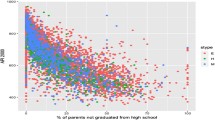Abstract
We use a finite population mixed model that accommodates response error in the survey variable of interest and auxiliary information to obtain optimal estimators of population parameters from data collected via simple random sampling. We illustrate the method with the estimation of a regression coefficient and conduct a simulation study to compare the performance of the empirical version of the proposed estimator (obtained by replacing variance components with estimates) with that of the least squares estimator usually employed in such settings. The results suggest that when the auxiliary variable distribution is skewed, the proposed estimator has a smaller mean squared error.
Similar content being viewed by others
References
Baker, F. B. 1992. Item response theory — Parameters estimation techniques. New York, NY: Marcel Dekker.
Biemer, P. 2009. Measurement errors in surveys. In Handbook of statistics, Vol 29, Sample surveys: Design, methods and applications, ed. D. Pfeffermann and C. R. Rao 281–315. Oxford, UK: Elsevier.
Bolfarine, H., and S. Zacks. 1992. Prediction theory for finite populations. New York, NY: Springer-Verlag.
Bolfarine, H., S. Zacks, S. N. Elian, and J. Rodrigues. 1994. Optimal prediction of the finite population regression coefficient. Sankhyā B, 56, 1–10.
DANE. 2009. Metodología muestra mensual de comercio al por menor. http://www.dane.gov.co/files/investigaciones/fichas/MMCM.pdf (accessed August 29, 2013).
Fuller, W. A. 1975. Regression analysis for sample survey. Sankhyā C, 37, 117–132.
Hambleton, R. K., and L. L. Cook. 1997. Latent trait models and their use in the analysis of educational test data. J. Educ. Measure, 14, 75–96.
Harville, D. A. 1997. Matrix algebra from a statistician’s perspective. New York, NY: Springer.
Holt, D., T. M. F. Smith, and P. D. Winter. 1980. Regression analysis of data from complex surveys. Jo. Ro. Stat. Soc. Ser. A 143, 474–487.
Kish, L., and M.R. Frankel. 1974. Inference from complex samples (with discussion). Jo. Ro. Stat. Soc. Ser. B, 36, 1–37.
Li, W., E. J. Stanek III, and J. M. Singer, 2012. Design-based random permutation models with auxiliary information. Statistics, A 46, 663–671.
Little, R. J. 2004. To model or not to model? Competing modes of inference for finite population sampling. J. Am. Stat. Assoc. 99, 546–556.
Morrison, D. F. 1983. Applied linear statistical methods. Englewood Cliffs, NJ: Prentice Hall.
Neter, J., M. H. Kutner, C. J. Nachtsheim, and W. Wasserman, 1996. Applied linear statistical models. Boston, MA: WCB/McGraw-Hill.
Pfeffermann, D., and D. J. Holmes, 1985. Robustness considerations in the choice of a method of inference for regression analysis of survey data. J. Ro. Stat. Soc. Ser. A, 148, 268–278.
Pfeffermann, D., and T. M. F. Smith. 1985. Regression models for grouped populations in cross-section surveys. Int. Stat. Rev., 53, 37–59.
Sen, A., and M. Srivastava. 1990. Regression analysis. theory, methods, and applications. New York, NY: Springer-Verlag.
Särndal, C. E., B. Swensson, and J. Wretman. 1992. Model assisted survey sampling. New York, NY: Springer-Verlag.
Stanek III, E. J., and J. M. Singer. 2004. Predicting random effects from finite population clustered samples with response error. Jo. Am. Stat. Assoc., 99, 1119–1130.
Stanek III, E. J., J. M. Singer, and V. B. Lencina. 2004. A unified approach to estimation and predition under simple random sampling. J. Stat. Plan. Inference, 121, 325–338.
Wu, C., and R. R. Sitter. 2001. A model-calibration approach to using complete auxiliary information from survey data. J. Am. Stat. Assoc., 96, 185–193.
Author information
Authors and Affiliations
Corresponding author
Rights and permissions
About this article
Cite this article
González, L.M., Singer, J.M. & Stanek, E.J. Estimation of Finite Population Parameters with Auxiliary Information and Response Error. J Stat Theory Pract 8, 772–791 (2014). https://doi.org/10.1080/15598608.2013.856358
Received:
Accepted:
Published:
Issue Date:
DOI: https://doi.org/10.1080/15598608.2013.856358



